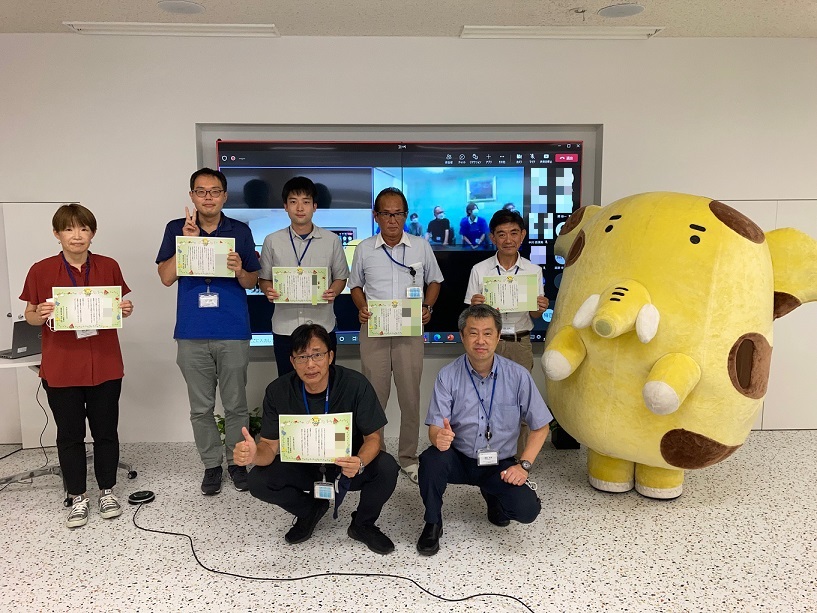Climate Change Initiatives
INDEX
- Concept of Climate Change
- Disclosure to TCFD Recommendations
- Governance Structure for TCFD
- ESG Management and Promotion Structure/Sustainability Committee Structure Sustainability Committee
- Strategy
- Risk Management
- Indicators and targets
- Trends in Scope1 CO2 Emissions and Per Unit of Net Sales
- Trends in Scope2 CO2 Emissions and Per Unit of Net Sales
- Disclosing actual figures on the Sanken Group's Scope3
- Third-party Verification
- Sanken Group's Efforts to Reduce GHG Emissions
- Response to the Energy Conservation Law and the Law Concerning the Promotion of Measures to Cope with Global Warming
- Utilization of renewable energy:GHG(Greenhouse Gases)Reduction of emissions
- Utilization status of Onsite PPA
- Activities to Reduce Electricity Consumption
- Fukushima Sanken Solar power installation (expansion)
- Fukushima Sanken By actively introducing "renewable energy", will use 100% renewable energy.
- Fukushima Sanken collaboration with Tohoku Electric Power Company
- Sanken Electric Semiconductor Reliability Evaluation Center
- Sanken Electric Manufacturing Development Center
- Sanken Electric Headquarters Energy Conservation Measures CO2 equivalent
- Energy Conservation Promotion Meeting
- Implementation of the "ESG Power Saving Competition"
Concept of Climate Change

The Sanken Group has been working to reduce CO2 at Group companies by implementing activities to reduce environmental impact. Climate change due to global warming is a risk that threatens the health of us all and the global environment, and it also affects our business, customers, and supply chain. We believe we must play a role in tackling the various problems caused by climate change.
In recent years, as a responsibility to the next generation, we have been carrying out business activities that further accelerate conventional moves to realize carbon neutrality. Currently, we will contribute from two perspectives: to provide eco-friendly, energy-efficient products, and to reduce the amount of CO2 emitted from our business activities.
While climate change poses risks, we also recognize that it is an opportunity to increase the corporate value of the Sanken Group.

Disclosure to TCFD Recommendations
One of the Sanken Group's basic CSR policies is to "contribute to the development of the global community by developing, producing, and selling power electronics and related products that use highly reliable and state-of-the-art technologies in order to realize a sustainable social environment." In order to realize a sustainable social environment, we recognize that responding to climate change is a key issue, and we are advancing initiatives and disclosing information in line with the recommendations of the Climate-Related Financial Information Disclosure Task Force (TCFD).
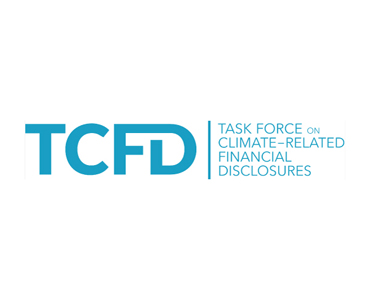
Governance Structure for TCFD
The Governance section of the TCFD (Task Force on Climate-related Financial Disclosures) recommendations requires the establishment and disclosure of a governance structure that responds to climate-related risks and opportunities. In our company, the Sustainability Committee, which deliberates on ESG management across organizations, plays a role. Katsumi Kawashima, Director in Charge of ESG, is appointed chairman of the committee, and the committee consists of members at the general manager level or higher in each division. The Committee conducts climate-related scenario analysis, identifies and assesses risks and opportunities related to climate change, and discusses and deliberates on measures to address risks and opportunities and reviews progress. As an advisory body to the President and Representative Director, the Committee reports to the Board of Directors at least twice a year the proposals submitted to and discussed by the Management Committee, and discloses information as appropriate. Sanken Electric discloses information on environmental activities related to climate change through CDP in response to requests from institutional investors, purchasing companies, and initiatives around the world.
Regarding climate-related issues, the following topics will be discussed.
- Climate-related scenario analysis
- Identification and severity assessment of short-, medium- and long-term climate-related risks and opportunities
- Strategic approach to identified significant climate-related risks and opportunities
- Consideration of specific responses to climate-related risks and opportunities
- Progress management of adopted responses to climate-related risks and opportunities
ESG Management and Promotion Structure/Sustainability Committee Structure Sustainability Committee
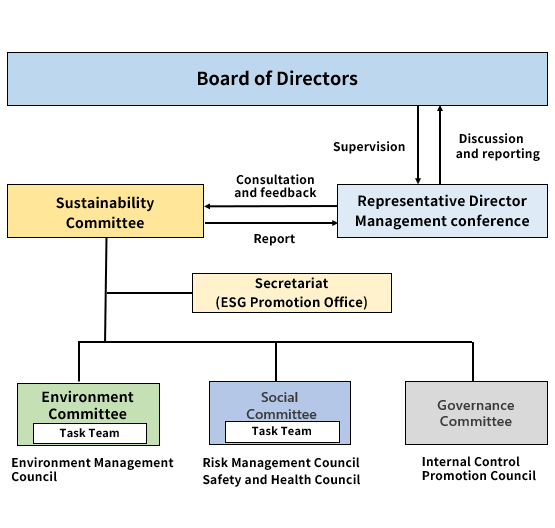
Strategy
The Sanken Group is engaged in the design, development, manufacturing, and sales of semiconductor and electronics products, and is expected to be affected by climate change in many ways. To this end, we conduct climate-related impact assessments through scenario analysis in order to identify risks and opportunities of climate change from a medium- to long-term perspective, to understand their impact on our group's business, and to incorporate appropriate responses into management plans.
In addition to the conventional 4°C scenario, we conducted an analysis using the 1.5°C scenario in a low-carbon economy, and found that there are transition risks due to the introduction of a carbon tax and financial risks due to high electricity prices.
In order to respond to the medium- to long-term (2030 and 2050) social and business environment changes associated with climate change, our company Sustainability Committee deliberates on the impact that social responses to climate-related issues and challenges can have on our company products and the entire supply chain, and identifies climate-related risks and opportunities. Because climate change risks and opportunities are risks and opportunities of our business activities themselves, we incorporate them into our management plans along with other risks.
| Worldview | Scenarios used in the analysis |
|---|---|
| 1.5℃, 2℃ | Sustainable Development Scenario (SDS), IEA, 2020, 2021 |
| Announced Pledges Scenario (APS), IEA, 2021 | |
| Representative Concentration Pathways (RCP2.6), IPCC, 2014 | |
| 4℃ | Stated Policy Scenario (STEPS), IEA, 2020, 2021 |
| Representative Concentration Pathways (RCP6.0, 8.5), IPCC, 2014 |
How to identify risks and opportunities
Climate change-related risks and opportunities for products and their entire supply chain were identified in each STEP.
| STEP1 | List of possible risks and opportunities |
|---|---|
| STEP2 | The following five criteria and three levels of importance were analyzed by the head of each division at the head office and plant. ● Magnitude of the impact if the risk materializes(Financial and Strategic) ●Affected period(How long the effects last) ● Frequency of occurrence(How often are risks affected when they materialize?) ● Potential to materialize(How likely is the risk to materialize?) ● Time of manifestation(How far in the future will the risk materialize?) |
| STEP3 | Summarize results and similar items.(Also consider the weight of items and the frequency of high importance) Identify five risks and three opportunities. The weight is evaluated and classified into 'large', 'medium' and 'small'. |
Risk
As a result of scenario analysis, our results could be significantly affected by increases in energy costs and other factors due to the introduction of policy measures to promote climate change measures, such as the introduction of a carbon tax, and the strengthening of regulations.
| Type | Major Risks | Policies | Level of importance | |
|---|---|---|---|---|
| Transition risk | Policies and Regulations | Rising fossil fuel prices increase electricity costs and operating costs | Reducing CO2 emissions ・Energy-saving activities ・Replacement of electricity with renewable energy ・Efficiency during production ・Optimization of transport ・Optimization of transport |
High |
| The introduction of a carbon tax raises operating costs | High | |||
| Decrease in sales due to decrease in demand for existing products due to new regulations on climate change | Expansion of sales through development of new energy-saving and highly efficient products under the medium-term business plan | Medium | ||
| Reputation | Delays in climate change measures reduce stakeholder confidence and market reputation | Formulate and implement plans to realize carbon neutrality | Medium | |
| Physical risk | Acute | Sales decline due to impact on production due to natural disasters, etc., suspension of suppliers' operations, and damage to logistics functions | Strengthening Risk Management by Enhancing the Crisis Management System | Low |
Opportunities
Scenario analysis results in the efficient use of energy resources and the provision of products that meet the low carbon needs of society and customers, which could have a significant impact on our results of operations.
| Type | Overview | Policies | Level of importance |
|---|---|---|---|
| Products and services | Increased sales due to the expansion of the market for products aimed at a low-carbon society (in-car, white goods home appliances, etc.) | ・Development of products for inverters ・Developing IPM ・Development of high-efficiency power supply devices ・Development of next-generation semiconductors |
High |
| Resource efficiency | Energy and resource conservation on production lines and in-house infrastructure | Introduction of DX and Smart Factories | High |
| Reputation | Improving Stakeholders' Trust by Promoting Low Carbon in Production | Formulate and implement plans to realize carbon neutral | Medium |
Risk Management
- The Sustainability Committee deliberates on climate change-related risks, and the contents of the deliberations are disseminated by the Management Committee and reported to the Board of Directors.
- IUnder the Sustainability Committee, we have established subcommittees dedicated to environmental (E), social (S), and governance (G) issues, and under the Social (S) Committee, we have established the Crisis Management Committee to deal with natural disasters and information management risks.
In addition, the Internal Control Promotion Committee has been established under the Governance (G) Subcommittee to support the inspection of operations at our company and Group companies, and to review and evaluate the effectiveness of control activities at the company-wide level and the business process level. The contents of these risk controls are reported to the Sustainability Committee, which comprehensively manages all business risks, including those related to climate change.
Indicators and targets
Based on the decision of the Paris Agreement in 2015, we conducted scenario analysis and found that in the scenario where the average temperature rises by 4°C due to climate change, the financial risk due to an increase in disaster risk such as flooding of bases as a physical risk, and in the scenario where the average temperature shifts to a low-carbon economy by 1.5°C, the transition risk due to the introduction of a carbon tax and the financial risk due to an increase in electricity prices are significant.
On the other hand, in the 1.5°C scenario, we also found that the development of EVs in automobiles creates sales opportunities for semiconductor devices for xEVs manufactured by our group. Of these climate-related risks and opportunities, the financial impact of the carbon tax was found to be the greatest, and it was found to be a climate-related issue that should be addressed with the highest priority.
CO2 Emission Reduction Targets of the Sanken Group
Goal
- The Sanken Group is targeting a 33% reduction in Scope 1 (energy-related CO2) and 2 for fiscal 2030, with 2020 as the base year for domestic and overseas (Dalian). (Scenario to limit the post-industrial temperature rise to less than 2°C)
- Going forward, we will accelerate our reduction activities toward 2030 and further develop measures to reduce the risk of climate change, while working toward carbon neutrality by 2050.
Specific measures
- Promotion of energy conservation activities in Japan and overseas
- Introduction of solar power generation
- Conversion to renewable electricity
Examples of Our Past Initiatives
- 2021: Established the Sustainability Committee
- 2022: Set CO2 reduction targets for the Sanken Group
- 2022: Achieved 100% renewable electricity procurement at Fukushima Sanken
- 2023: Introduced on-site PPA at Horimatsu and Noto plants of Ishikawa Sanken
- 2023: Introduced on-site PPA at Fukushima Sanken
- 2023: Introduced on-site PPA at Dalian Sanken Electric and partially transitioned purchased electricity to wind power
- 2023: Streamlined Environmental ISO certifications; integrated EMS in August, JQA audit completed in March 2024
- 2024: Expanded wind power share in purchased electricity at Dalian Sanken Electric
About Scope3
- Scope3 emissions in the Sanken Group were 388kt-CO2 (FY 2024).
- We will continue to improve the accuracy of Scope 3 emissions calculations and establish reduction targets moving forward.
Trends in Scope 1 Emissions and Per Unit of Net Sales
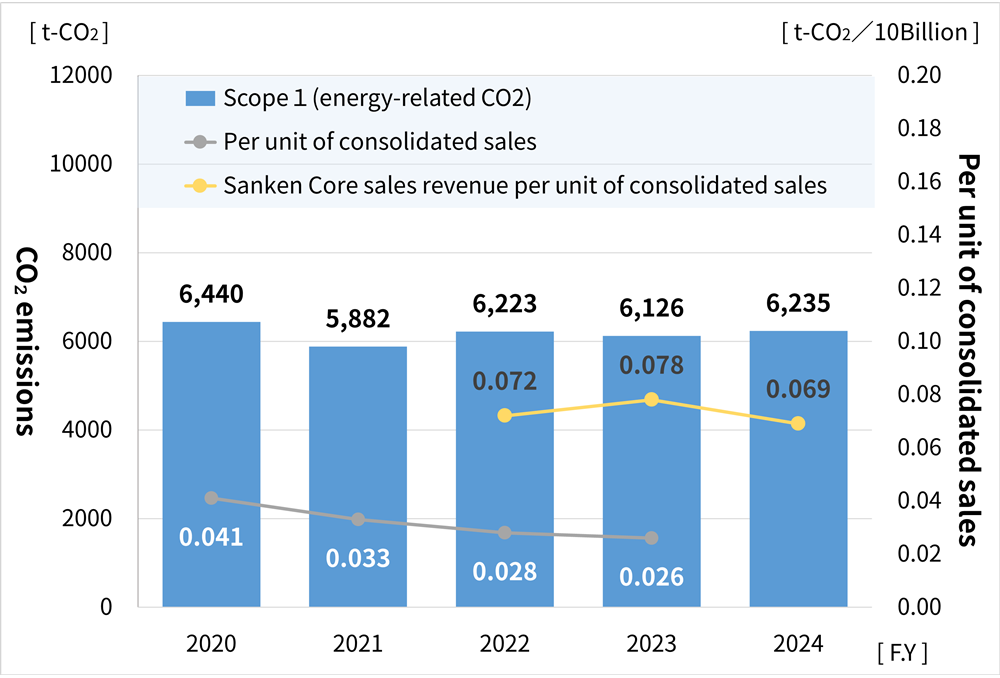
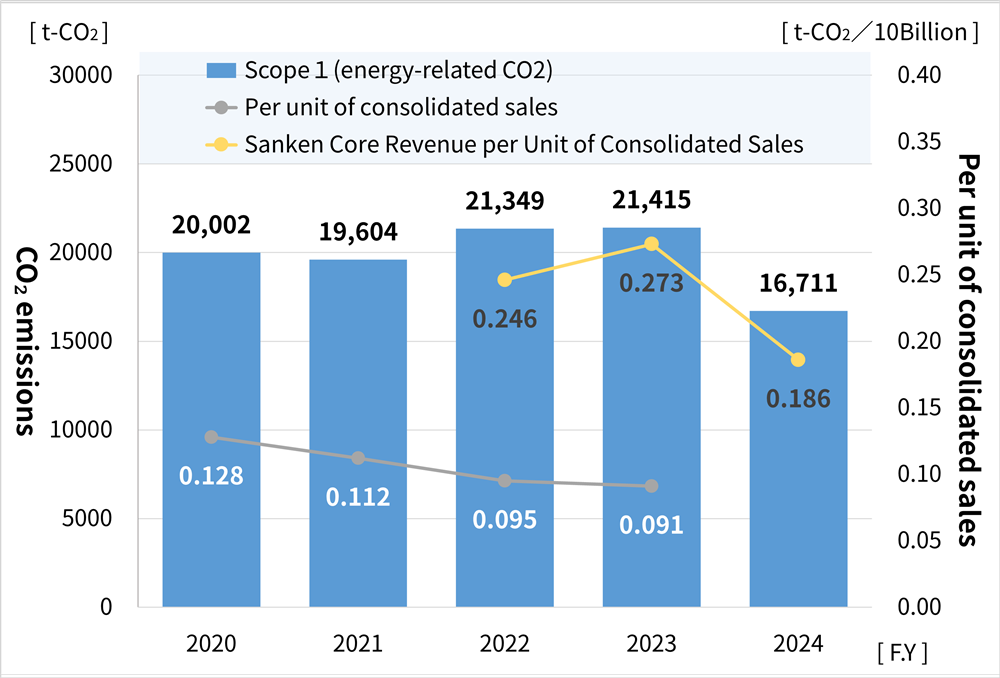
Trends in Scope2 CO2 Emissions and Per Unit of Net Sales
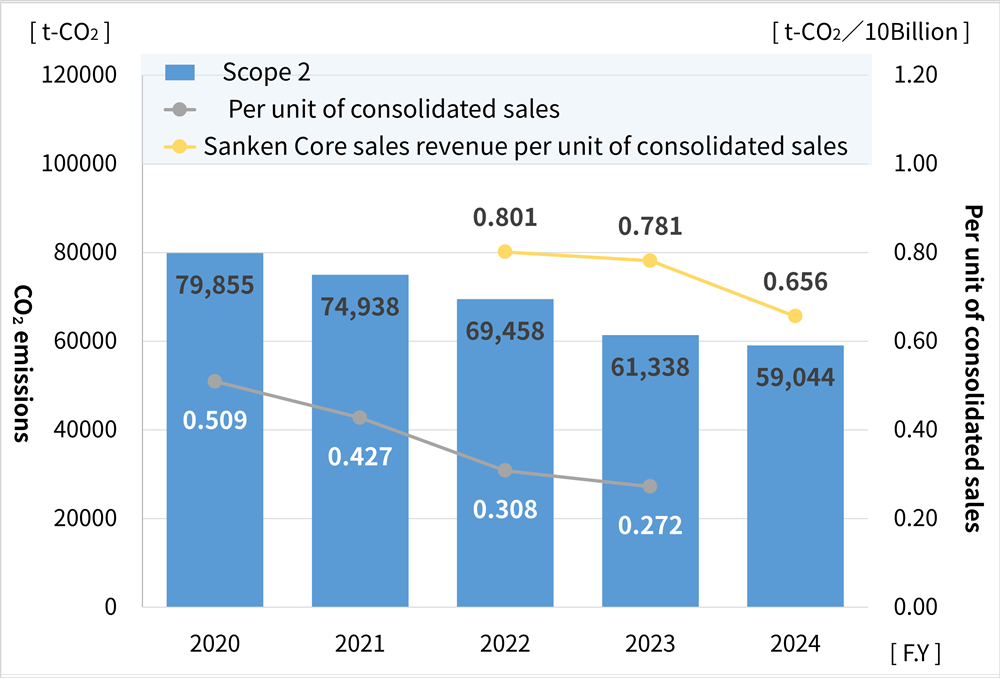
Reduction Rate of Energy-derived CO2 Emissions (Compared to FY2020)
| Target | Actual | ||||
|---|---|---|---|---|---|
| 2021 F.Y | 2022 F.Y | 2023 F.Y | 2024 F.Y | ||
| Scope 1 Reduction rate | ー | 8.7% | 3.4% | 4.9% | 3.2% |
| Scope2 Reduction rate | ー | 6.2% | 13.0% | 23.2% | 26.1% |
| Total reduction rate | Compared to FY2020 33%Reduction | 6.3% | 12.3% | 21.8% | 24.4% |
Disclosing actual figures on the Sanken Group's Scope3
Of the Sanken Group's GHG emissions, 80% are from products and services purchased in Category 1 (No. 1 Fundri, No. 2 Wafer, 30kt-CO2). In other areas, the ratio of transportation and delivery (upstream and downstream) energy-related activities is relatively large, and we will formulate new reduction targets for Scope3 based on the results of calculations in the future.
| NO. | Category | FY2020 (t-CO2) | FY2022 (t-CO2) | FY2023 (t-CO2) | FY2024 (t-CO2) |
|---|---|---|---|---|---|
| ① | Purchased goods and services | 204,823 | 230,458 | 244,216 | 306,712 |
| ② | Capital goods | 9,437 | 17,259 | 18,087 | 11,733 |
| ③ | Fuels and energy-related activities not included in Scope1 and 2 | 11,651 | 9,999 | 40,956 | 38,176 |
| ④ | Transportation and Delivery (Upstream) | 3,933 | 11,486 | 8,926 | 10,451 |
| ⑤ | Waste generated in operations | 288 | 3,667 | 2,654 | 2,590 |
| ⑥ | Business Trip | 463 | 365 | 340 | 329 |
| ⑦ | Employer's commutation | 1,072 | 1,250 | 4,144 | 3,808 |
| ⑧ | Upstream leased assets | Not eligible | Not eligible | Not eligible | Not eligible |
| ⑨ | Downstream transportation and distribution | 9,632 | Not eligible | Not eligible | Not eligible |
| ⑩ | Processing of sold products Not eligible | Not eligible | Not eligible | Not eligible | Not eligible |
| ⑪ | Use of sold products | Not eligible | Not eligible | Not eligible | Not eligible |
| ⑫ | End of life treatment of sold products | 1,538 | 11,452 | 9,890 | 14,157 |
| ⑬ | Downstream leased assets | Not eligible | Not eligible | Not eligible | Not eligible |
| ⑭ | Franchise | Not eligible | Not eligible | Not eligible | Not eligible |
| ⑮ | Investment | Not eligible | Not eligible | Not eligible | Not eligible |
| Total | 242,837 | 285,935 | 329,213 | 387,957 |
Third-party Verification
The Sanken Group undergoes third-party verification by specialized organizations to ensure the reliability and transparency of greenhouse gas (GHG) emissions data.
Sanken Group's Efforts to Reduce GHG Emissions
We are actively investing in energy-saving activities at each business site, capital expenditures to reduce CO2 emissions during facility renewal, aggressive introduction of photovoltaic power generation at each business site, and active utilization of renewable energy and natural energy.
Response to the Energy Conservation Law and the Law Concerning the Promotion of Measures to Cope with Global Warming
Based on the Energy Efficiency and Energy Conservation Law and the Warm Response Law, energy management supervisors are selected and all business sites subject to performance reporting submit medium-and long-term plans and periodic reports to the authorities in charge of energy management. We will continue our efforts to manage and effectively utilize energy based on laws and regulations. As part of our efforts to promote "renewable energy," we are promoting the introduction of "solar power generation" throughout the company. Fukushima Sanken has already introduced this system, and Ishikawa Sanken is also scheduled to be introduced.
Utilization of renewable energy:GHG(Greenhouse Gases)Reduction of emissions.
The Sanken Group is actively promoting the use of renewable energy to reduce GHG emissions. Since April 2022, Fukushima Sanken has switched most of its electricity use to renewable energy. In fiscal 2023, we introduced solar power generation using on-site PPA *. Ishikawasanken Horimatsu Plant and Noto Plant also introduced the system.We are working to achieve our medium- to long-term GHG emission reduction targets.
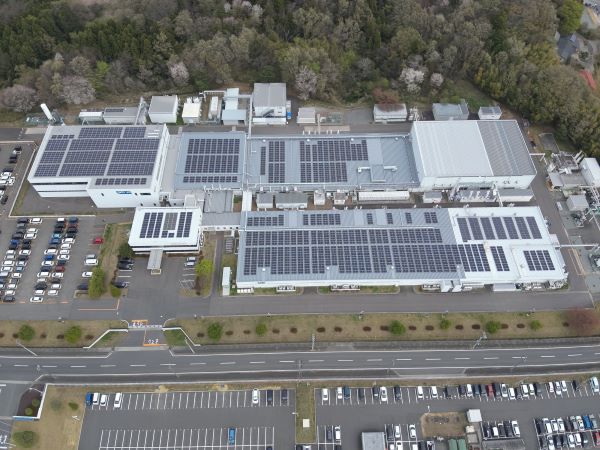
- A system whereby a power generator provides electricity by installing a power generation facility on the premises of a user(PPA Business operator)
Utilization status of Onsite PPA
Projected values after the introduction of on-site Power Purchase Agreements (PPA) (Ishikawa Sanken installation in April 2023, Fukushima Sanken implementation in May 2023).
| facility | Onsite PPA electricity ratio | Converted to equivalent electricity usage for general households |
|---|---|---|
| Ishikawa/Horimatsu | 19% | Equivalent to annual electricity usage of approximately 1,500 households. |
| Ishikawa/Noto | 9% | |
| Fukushima | 5% | |
| Total | 12% |
Fukushima Sanken Solar power installation (expansion)
Installation (start of operation) from December 2020〜
As a means of introducing renewable energy, we added 202.5kW solar panels on the roof of the No. 3 building to enhance the
energy-saving effect and enhance the toughness of the factory. In addition, we were able to drastically reduce the operation of air conditioners in summer due to the heat shielding effect
In the fiscal year 2022, we installed additional solar panels capable of generating 500kW. These panels offset 2.06% of the total electricity consumption in the same fiscal year, and 2.15% in the fiscal year 2023.
| Generation output | 202.5kW (supports overloading) |
|---|---|
| Power conditioner | 10 kW x 15 units |
| Investment amount | 31.6 million yen |
In fiscal 2022, we plan to increase the number of photovoltaic panels capable of generating 500kW to supplement 7% of the total power consumption.
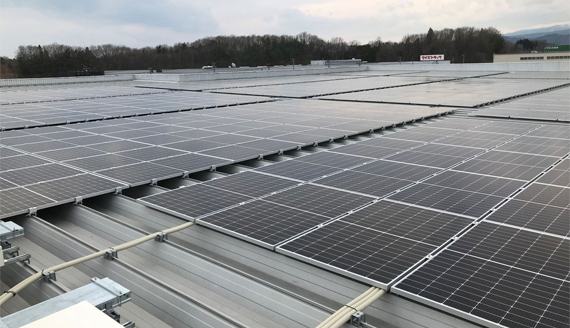

Fukushima Sanken By actively introducing "renewable energy", will use 100% renewable energy.
Since April 2022, we have switched all electricity used from 100% renewable energy sources. We plan to reduce 7000 tons of CO2 emissions annually by purchasing electric power generated from Tohoku Electric Power Co., Inc., including hydroelectric and geothermal power.
Fukushima Sanken collaboration with Tohoku Electric Power Company
In order to gain a more detailed understanding of the origin of renewable energy, we inspected hydroelectric and geothermal power stations with the cooperation of Tohoku Electric Power Co., Inc. The Yanagitsu Nishiyama Geothermal Power Plant is a power plant developed in consideration of geomorphology and harmony with the natural environment.
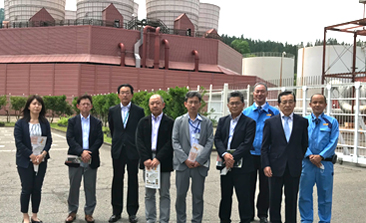
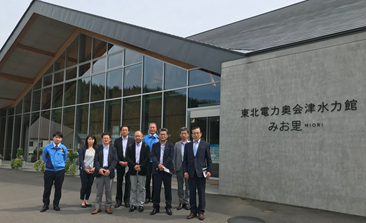
Sanken Electric Semiconductor Reliability Evaluation Center
In April 2019, the Semiconductor Reliability Evaluation Center started operation at the Ishikawa Sanken Head Office site. By consolidating the product evaluations that had previously been dispersed among the several locations of the head office and Ishikawa Sanken into one location, we were able to improve the evaluation speed of product development.
In terms of the environment as well, we were able to reduce electric power charges by 22 million yen per year by improving air conditioning efficiency through the consolidation of floor design and evaluation equipment that takes waste heat into account.
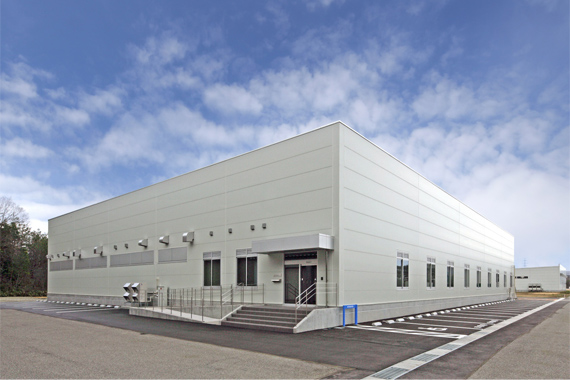
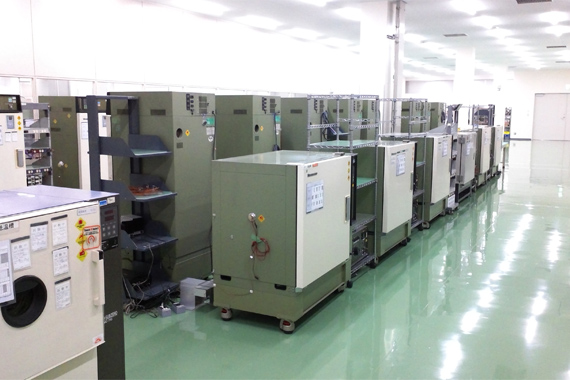
Sanken Electric Manufacturing Development Center
In April 2021, we constructed a Monozukuri Development Center on the premises of our head office to serve as a base for platform development technology that integrates development and production, and are working to improve the efficiency of new product development.
In terms of the environment, we have also adopted light shelves and top lights for indoor lighting. CASBEE rating A has been achieved through the use of natural energy by incorporating daylight.
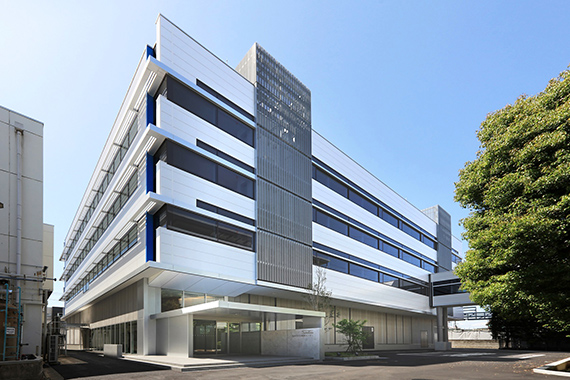
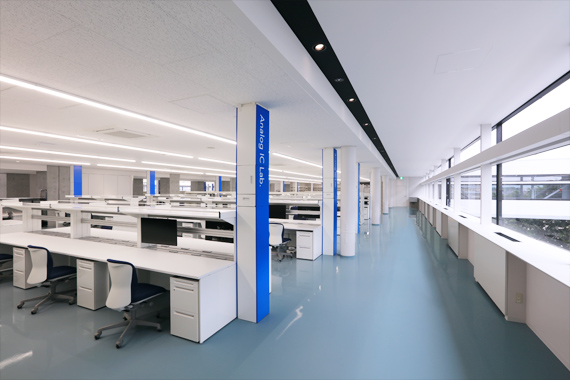
Sanken Electric Headquarters Energy Conservation Measures CO2 equivalent
In fiscal 2021, we reduced electricity consumption by implementing the following energy-saving measures.
| Improvement content | Usage (yearly) | ||
|---|---|---|---|
| Reduced power | CO2 conversion | Monetary conversion | |
| Pump unit renewal (5.5kw → 3.5kw) | 30,660 kwh | 13,521 kg | 613,200 yen |
| Meeting room air conditioner renewal (23.5 → 21.5 kW) | 3,456 kwh | 1,524 kg | 69,120 yen |
| Use of LED lighting fixtures (54 units) | 2,477 kwh | 1,092 kg | 49,540 yen |
| Reduction effect | 36,593 kwh | 16,138 kg | 731,860 yen |
- CO2 conversion is calculated from the emissions coefficient of TEPCO's energy partners in fiscal 2020, which is 0.441kg-co2/kwh.
- Money conversion is calculated based on the head office electricity bill.
- Decimal place is truncated.
Energy Conservation Promotion Meeting
We recognize the importance of reducing emissions of CO2, which is a greenhouse gas, and are working to conserve energy. The Energy Conservation Promotion Committee works to resolve issues that are being improved in each department and to develop measures that can be deployed to other departments horizontally. At the same time, periodic patrols confirm the operation status and identify points for improvement.
Implementation of the "ESG Power Saving Competition"
2022 In response to requests from the government and electric power companies for saving electricity due to the intense heat in the summer of the year, we received 380 entries from group companies when we received a wide range of ideas for saving electricity from our employees. The goal of ESG Power Conservation Competition is to view ESG issues in the world as "self-affairs" and to challenge social issues cheerfully and enjoyably. We will continue to take various measures to deepen the understanding and penetration of the Sanken Group's ESG management philosophy among employees.
